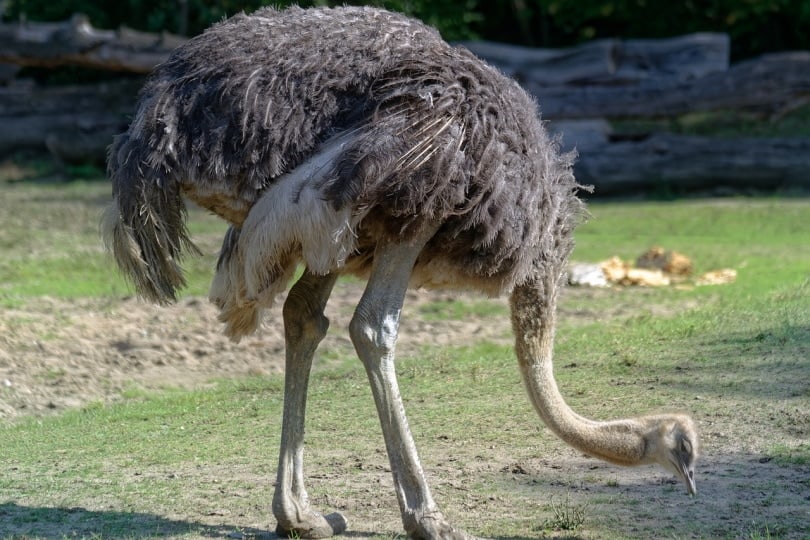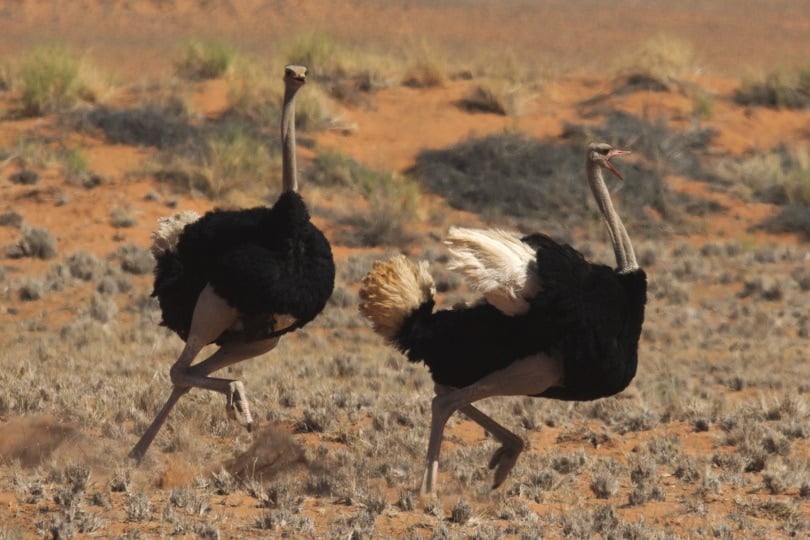Animals can do some pretty strange things at times. Even though you’ve heard something about an animal a hundred times, it doesn’t necessarily mean that behavior is accurate. When it comes to ostriches, one of the weirdest behaviors that we hear about is that they bury their heads in the sand. Why do they do this?
Let’s start by clearing one thing up: ostriches do not bury their heads in the sand. You read that right. Somebody may have told you when you were a little kid that this is something these flightless birds do, but it’s all one big myth. Let’s look at some accurate details of these birds and the common behaviors they do have.

Ostrich: An Overview
| Common Name: | Ostrich |
| Scientific Name: | Struthio camelus |
| Animal Type: | Bird |
| Group Name: | Herd |
| Diet: | Omnivore |
| Lifespan: | 30 – 40 years |
| Size: | 7 – 9 feet tall |
| Weight: | 220 – 350 pounds |

Do Ostriches Bury Their Heads in the Sand?
You may have seen this stereotypical image of an ostrich with its head buried in the sand in cartoons growing up. Some of your teachers might even have mentioned this odd behavior to you. Many people assume that it is because they try to hide when they feel threatened or scared. The truth is that this behavior is a myth and isn’t something that ostriches actually do.
Animal experts believe that this rumor started because of another behavior of these birds. Ostriches often dig shallow holes in the ground that they use as a nest for their eggs. They put their head near the ground when using their beaks to turn their eggs several times throughout the day. If you were to observe them from a distance, it is possible that it looks like they are burying their heads in the ground.
Another way this myth could have started is from observing the birds eat. Ostriches are omnivores and often put their heads near the ground when foraging for food. From a distance, it’s easy for your eyes to deceive you.


Ostriches Facts
Ostriches are flightless birds. In fact, they are the world’s largest birds. They roam desert lands and savannas in Africa and get most of their water from the plants that they eat. Here are some other interesting pieces of information about these large birds:
Speed
Ostriches cannot fly, but they are very strong runners. An adult ostrich can sprint up to 43 miles an hour! For longer distances, they average 31 miles per hour. Their powerful legs can even cover 10–16 feet in one stride.

Behaviors and Diet
Ostriches typically eat plants, seeds, and roots, but sometimes eat lizards or insects, depending on their habitat and what food is available to them. Their plumage blends in well with the sandy soil of their environments.
These animals tend to live in small herds of less than a dozen birds. The alpha males usually mate with the herd’s most dominant hen, although they do mate with others in the group at times. All eggs from the birds get places in the dominant hen’s nest, yet hers are given the priority of the center of the nest for better incubation. Each ostrich egg can weigh more than two dozen chicken eggs.

Final Thoughts
Now that you know the truth about these giant birds, you can pass the information over to your friends and family and let them know that what they were taught over the years has never actually been true! While it’s understandable why someone would believe this, it takes a much closer look and many hours of observation to understand these birds’ behaviors and the reasoning behind them.
Related Reads:
Featured Image Credit: Wirestock Creators, Shutterstock
